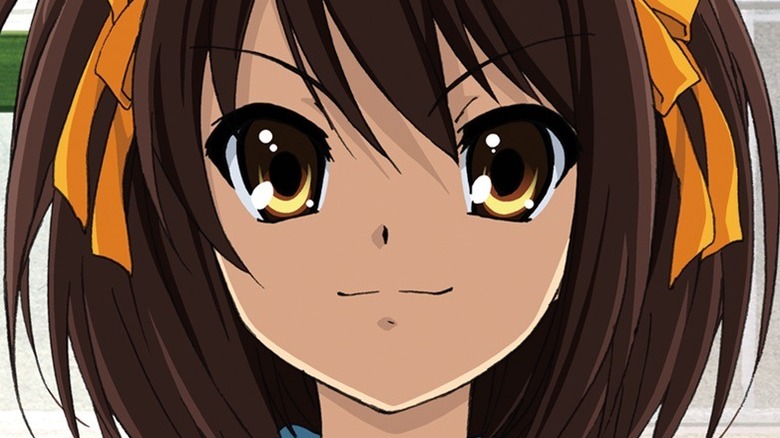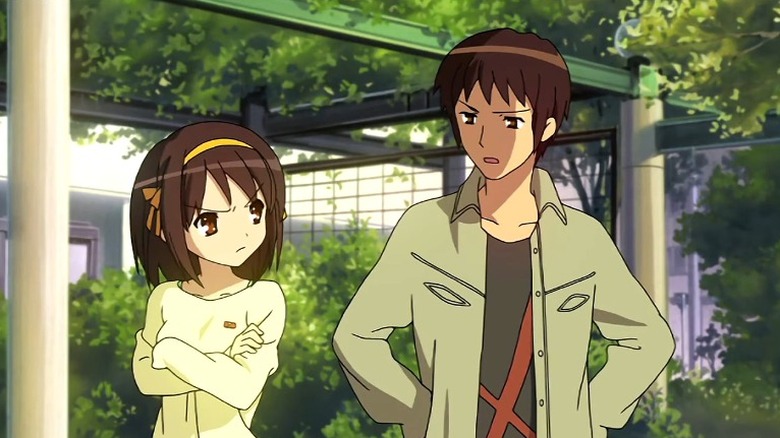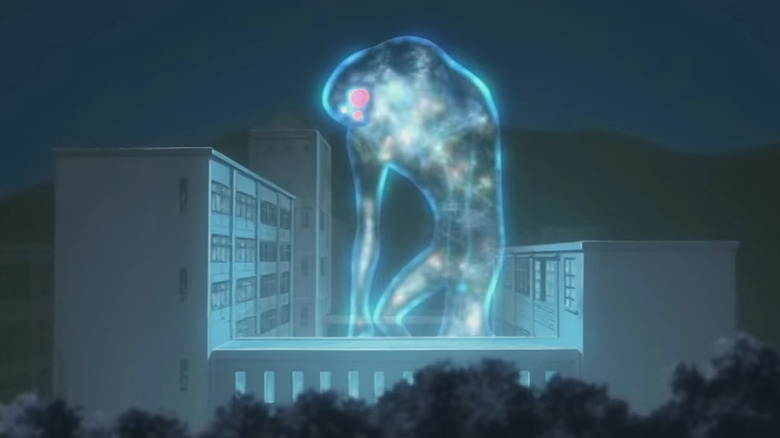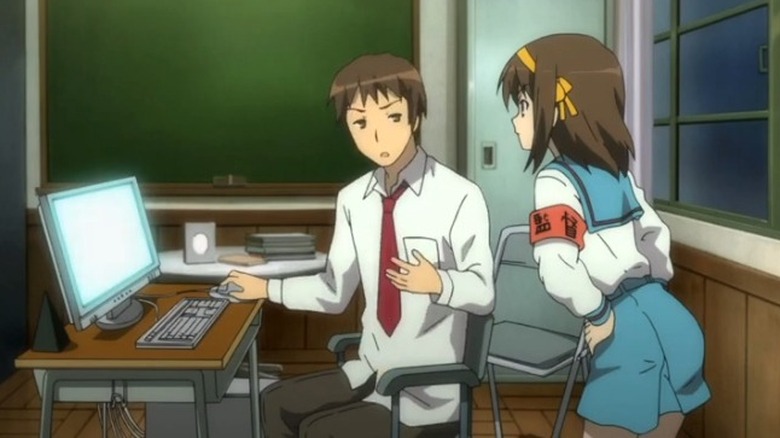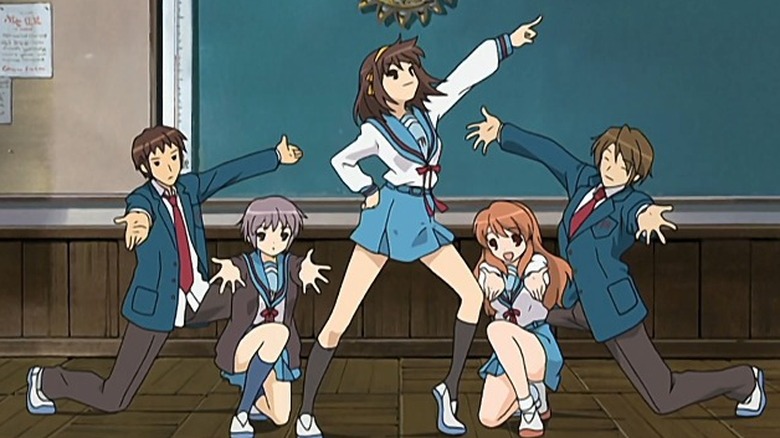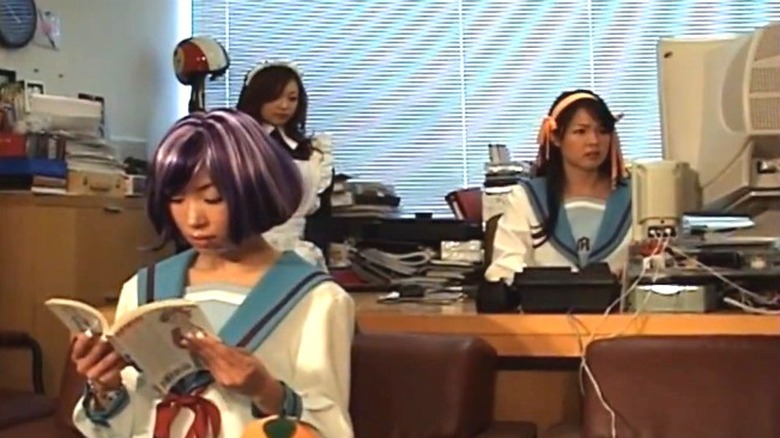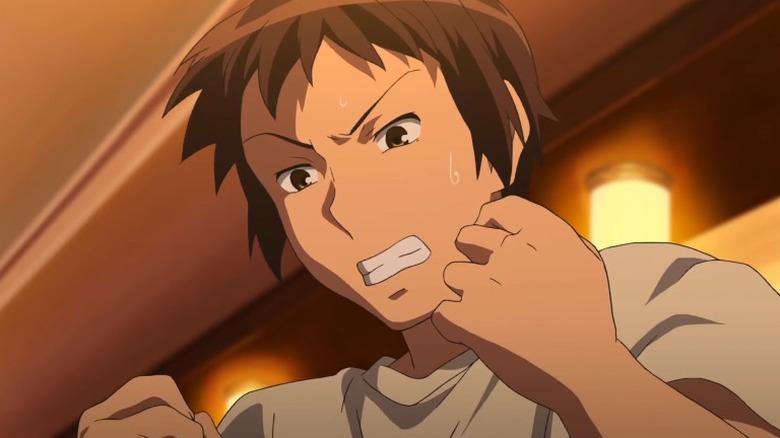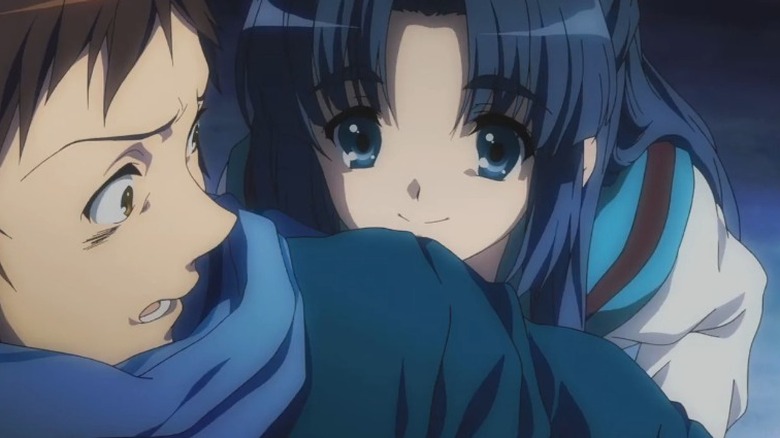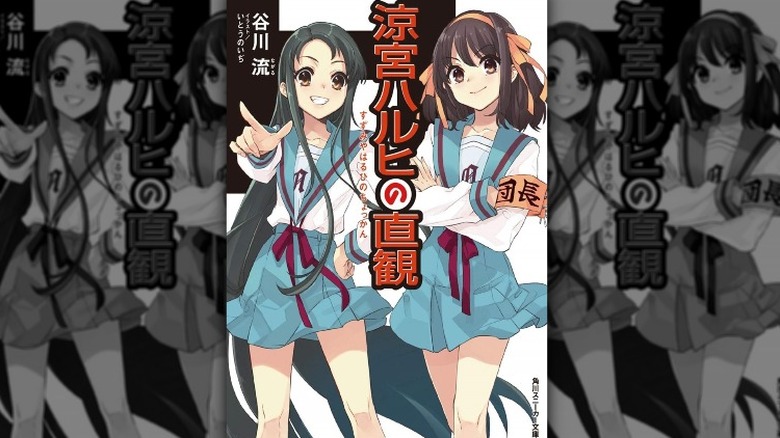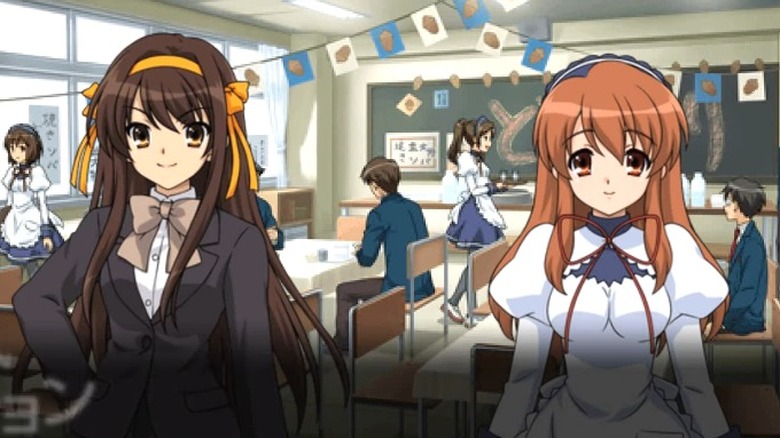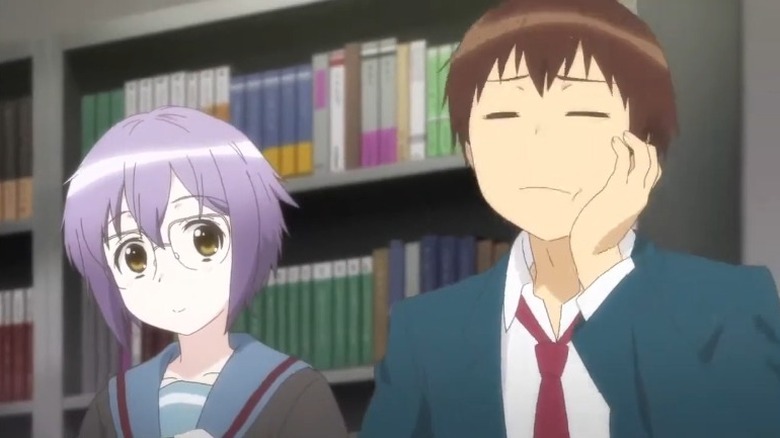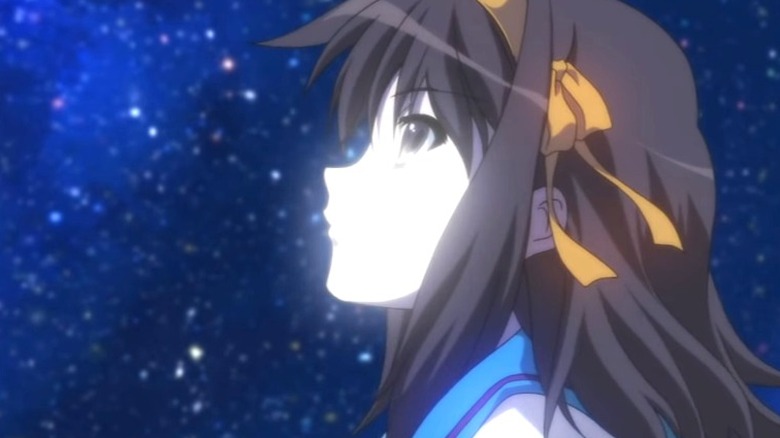How The Melancholy Of Haruhi Suzumiya's Short Run Still Managed To Change Anime Forever
In 2006, "The Melancholy of Haruhi Suzumiya” took the anime world by storm. The series tells the story of Haruhi Suzumiya, a schoolgirl who inadvertently gains god-like powers, and the esper, alien, and time traveler that desperately try to make her happy without revealing her true nature. The mixture of science fiction and slice of life themes struck a chord with anime fans, who found Haruhi's existential crisis deeply relatable. They also loved unlocking the secrets hidden within the show's official site, cosplaying as the characters, and recording themselves trying to replicate the dance performed by the cast at the end of each episode.
Despite the success of the anime, only two seasons and a film were released. This accounted for approximately half of the story arcs found in the novels, leaving a lot of content to be adapted and millions of fans around the world eager to see more episodes. Sadly, this never came to be. Instead, viewers had to settle with manga and video game spin-offs, and an obscure live-action series created to promote the show overseas.
In the last few years, anime enthusiasts have been able to better understand what made this series so unique. The lack of a third season, which troubled fans for years, is a lot easier to explain today, as is the influence the show had on otaku culture and the industry in general. Let's take a look at how "The Melancholy of Haruhi Suzumiya" managed to change anime forever.
The creator's hometown became a tourist hotspot
It's no secret that many anime creators like to draw inspiration from real life locations. People can visit the stairs where the protagonists of "Your Name" meet in Yotsuya, or enjoy the forests that inspired the backgrounds of "Princess Mononoke" by visiting the island of Yakushima. "The Melancholy of Haruhi Suzumiya" is no exception, as many of the show's locations were inspired by landmarks in Nishinomiya, hometown of the light novel's author Nagaru Tanigawa.
When "Haruhi Suzumiya" was at the peak of its popularity, it was not uncommon to see fans of the show sightseeing in this beautiful city, located in Japan's Hyogo prefecture. People would regularly be seen visiting the building where Yuki's apartment is located in the anime and walking around Nishinomiya-Kitaguchi Station, where the show's team of supernatural investigators frequently meet. Perhaps the most popular destination for fans visiting the city was (and still is) the school that the SOS brigade attends.
Fans who visit the author's hometown will no doubt immediately recognize Kita High as the inspiration for the main location in the series. In fact, the school became so popular with "Haruhi Suzumiya" fans that some went as far as trespassing, recreating some scenes from the show. Sadly, as Automaton reports, low birth rates in the area have led to the student population declining to the point that the school might be merged with another one.
The fate of the once-popular building is uncertain, but one thing's for sure — "The Melancholy of Haruhi Suzumiya" helped to kickstart the trend of anime fans visiting the real life locations featured in their favorite shows.
The episodes were released in non-chronological order
As light novels started to become more popular in the 1990s, authors began experimenting with new narrative techniques. This included telling the stories in a non-chronological order. "Boogiepop and Others," for example, is presented as a collection of short stories. They work as pieces of a complex puzzle that, when put together, describe the events of the main plot. Years later, the "Haruhi Suzumiya" series would follow an even more innovative structure, taking things to the next level.
Sometimes, the chapters within a volume contain events that happen in chronological order, like in the case of the first light novel. However, some chapters and entire volumes jump into the future, keeping readers on their toes. Given that most volumes and some chapters feel like self-contained stories, people can read the light novels in pretty much any order they like.
Inspired by the unique nature of the original material, Tatsuya Ishihara (the anime's director) decided to choose specific arcs from the first six volumes and organize them in a way that provided the most enjoyable viewing experience, as well as the biggest payoff during the ending. When Kyoto Animation finished producing the additional episodes that compose the second season, these were released intermittently during a rebroadcast of the original show.
In the years since, numerous anime shows have followed suit and refused to follow chronological order, with varying results. Series like "The Tatami Galaxy," "Humanity Has Declined," and "Princess Principal" have all made particularly good use of this approach.
The viewing order debate helped solve an old math problem
The 2009 rebroadcast of "The Melancholy of Haruhi Suzumiya," which added the new episodes from Season 2 and changed their order, motivated fans to come up with their own viewing suggestions. YouTube channel Weeb Jail, for example, suggests that chronological order isn't that important as long as the episodes initially broadcast at the end are watched last. Others suggest that viewers skip "Endless Eight" except for the first two episodes of the arc and the last one (via Otaquest). Curiously, the debate about the best way to watch the show moved beyond simple narrative optimization. Before long, math enthusiasts within the community started asking more complex questions.
Let's imagine that a fan wants to find out which viewing order provides the best possible experience. In order to achieve this, this person would have to watch the first 14 episodes in different order multiple times, until every combination possible has been achieved. At one point, fans asked themselves what would be the shortest possible string of episodes that have to be watched in order to watch every possible combination. As The Verge explains, one 4chan user managed to find a formula that solved the issue. At the same time (and without realizing this), the anonymous poster also found a solution to a mathematical problem in the field of combinatorics that experts had been trying to work out for a long time. For those who are curious, the minimum number of episodes a fan has to watch in order to see every possible combination of Season 1 is 93,884,313,611.
It popularized the trend of recreating anime dances
There are few things that anime fans appreciate more than a great opening or ending theme. "The Cruel Angel's Thesis" and "Tank!" set the right mood for the events about to unfold in "Neon Genesis Evangelion" and "Cowboy Bebop," respectively. But sometimes the most memorable themes are those which feature the cast singing and dancing to the music. "Kaguya Sama: Love is War" had a good opening, but it couldn't compete in popularity with "Chikatto Chika Chika," an ending that featured the popular character dancing in an outstandingly animated sequence. Like the opening of "Lucky Star" years before, which also featured the cast dancing, the sequence led to numerous parody videos and recreations. But probably the most famous of these trends took place in 2006 when fans of "The Melancholy of Haruhi Suzumiya" were introduced to the contagious melody of "Hare Hare Yukai."
In the late noughties, video streaming sites like Nico Nico Douga and YouTube were starting to become increasingly popular. So, when "The Melancholy of Haruhi Suzumiya” started to gain attention, fans couldn't think of a better way to demonstrate their love for the show than replicating the dance featured in the original ending. As Anime News Network states, however, it's hard to calculate how many videos were uploaded, as YouTube deleted most of them due to copyright infringement. As a result, one of the most popular trends of the 2000s, which perfectly encapsulates the culture of anime fandom at the time, has almost been almost completely wiped from the internet.
The marketing campaign included a series of live-action shorts
Watching "The Melancholy of Haruhi Suzumiya" might not elicit the same response today as it did during its release in 2006. It might be that Haruhi's existential crisis is not as relatable to audiences today as it was for young anime fans in the mid-2000s. However, it might also have a lot to do with the creative marketing campaign launched to promote the show.
An SOS Brigade website, replicating the one the characters created in the series, went online during the show's broadcast. The site would occasionally provide viewers with puzzles that revealed clues, like an image from the film "The Disappearance of Haruhi Suzumiya" accompanied by the production credits. It would also release cryptic footage containing information about future plots. However, the most ambitious and curious marketing strategy came in the form of a live-action series.
"The Adventures of the ASOS Brigade" told the story of Haruhi, Yuki, and Mikuru, as they tried to establish a branch of their team in North America. The series, as the YouTube channel Tonsa explains, has a low-budget feel, resembling something a group of high school students would produce. It would also break the fourth wall frequently, as the cast would supervise and interview the actors recording the English dub for Season 2. Interestingly, finding the episodes now is not easy, as they were only released on a now-defunct website and on certain DVDs.
Of course, it's not uncommon to see live-action adaptations of anime made for Western audiences nowadays. Netflix has led the way with this, though the results thus far have not been great — its "Death Note" movie and its "Cowboy Bebop" series both failed to inspire.
It took the time loop trope to new extremes
In the original light novel, the "Endless Eight" arc is simple: The characters find themselves repeating the last day of summer in a time loop. Eventually, they figure out that Haruhi has been repeating the day because she feels that their perfect summer is incomplete due to them not being able to finish their homework. How do you adapt this for the screen without it becoming extremely repetitive? With great difficulty, it transpired.
In order to understand why people hate "Endless Eight," we have to enter the mindset of a Haruhi fan in the late 2000s. People were avidly reading the light novel and recording themselves dancing to the music while they waited for the new episodes. During this four-year wait, the sequel was announced, then canceled and replaced by the promise of a movie. As YouTuber Red Bard explains, this confused fans.
In 2009, 14 new episodes finally dropped. Fans rejoiced and enjoyed the first episode of the new season, titled "Bamboo Leaf Rhapsody." The next episode, "Endless Eight I" was a simple summer-themed story. Nobody thought too much about it until next week with the release of "Endless Eight II," which featured the characters reliving the same day and realizing they are trapped in a loop. Fans expected "Endless Eight III" to provide a resolution. Sadly, this didn't happen, and viewers had to spend eight weeks watching virtually the same episode.
Whether this was a brilliant attempt by the director to make fans experience the same frustration the protagonist goes through, or just a trick to save resources during production, we'll never know. What we do know is that the time loop trope has been used in several successful anime series since, from "Steins;Gate" to "Re:Zero – Starting Life in Another World."
It paved the way for better movie spin-offs
Dedicating eight episodes of Season 2 to "Endless Eight" felt a bit unfair to viewers. After all, they had waited four years to watch a second season, only to see more than half of it essentially be the same episode reshot in slightly different ways. Curiously, the second season was initially planned to be a bit longer.
As the managers and writers of the film "The Disappearance of Haruhi Suzumiya" explained in an interview for the movie's guidebook, this arc was originally expected to be part of the second season. The intention was to adapt the entire plot and to give each scene the necessary length to properly portray the story. By the time the studio decided to adapt the arc in the form of a movie, the staff already had scripts for several episodes.
The result was a 162-minute movie, one of the longest in anime history. Despite its unusual length, the director and the studio decided to keep many scenes, which only helped the story. The characters' motivations and feelings were clear as a result, which led to an engaging and surprisingly emotional film. In a way, the positive reception received by "The Disappearance of Haruhi Suzumiya" helped undo some of the damage done by "Endless Eight" and pave the way for other successful anime movies.
In the past, anime films spun off from existing shows were largely filler seen as really long filler episodes, with fans rarely considering them to be canon. The success of "The Disappearance of Haruhi Suzumiya" helped to change that — movies from the "Dragon Ball" and "Demon Slayer" franchises have done huge numbers. Sadly, it wasn't enough to ensure the production of a third season.
Light novel sales made a third season unnecessary
In the west, TV has always been traditionally supported by ad revenue. TV shows could be canceled after a few episodes, or go on for decades depending on how many people were watching the show and, therefore, the ads. But things are a bit different in the world of anime. The series that end up being produced are not necessarily financed through advertisement. Instead, they are expected to increase the sales of official merchandise like soundtracks, figures, and Bluray releases. When an anime series is based on a popular manga or light novel, the intention is specifically to boost the sales of the original material, something that "The Melancholy of Haruhi Suzumiya" excelled at.
Before the anime adaptation had aired, the "Haruhi Suzumiya" series had seven published light novels and had sold 1.5 million books. Just a few months after the anime made its debut, this number would increase to 2.8 million. The release of the second season only made the light novels more popular. Overall, according to a 2017 report, the franchise had sold over 20 million copies globally. Any decline in interest was minimized when, after almost a decade, the author of the light novels released a new volume. According to Crunchyroll, 2020's "The Intuition of Haruhi Suzumiya" sold surprisingly well both in Japan and around the world, making a third season of the series unnecessary, at least from a marketing point of view.
The Disappearance of Haruhi Suzumiya has a video game sequel
While the light novels continue to sell, it's fair to say that the disappointing release of the new episodes of "The Melancholy of Haruhi Suzumiya" led to declining interest in the franchise at the time. This changed with the release of "The Disappearance of Haruhi Suzumiya," a film that took advantage of long scripts and creative filmmaking to provide audiences with well-developed characters and a visually compelling story. As a result, the movie became a success in terms of box office and DVD sales. It was also acclaimed by viewers, reaching a 94% user score on Rotten Tomatoes.
In 2011, Namco Bandai released "The Reminiscences of Haruhi Suzumiya" for the PlayStation 3 and PSP in Japan, a visual novel with an original story that served as a sequel to the movie. The game allows players to revisit the alternative reality depicted in the film for a short period of time, using Mikuru's time-traveling abilities to relive certain events until the player figures out the actions and dialogue choices required to get a good ending. Interestingly, the film would also lead to the creation of another spin-off based on one of the movie's most popular characters.
Yuki got her own manga and anime spin-off
The popularity of "The Disappearance of Haruhi Suzumiya" (which has been compared to Makoto Shinkai's hit anime film "Your Name") led to the release of a manga spin-off. "The Disappearance of Nagato Yuki-chan" focuses on the character of Yuki; at least the way she's depicted in the movie. In this reality, Yuki is a normal girl who loves to read books and spend time with her friends. It also explores the romantic feelings Yuki starts developing towards this world's version of Kyon, something that, to a certain extent, the movie hinted at.
The manga was first published in 2009 and was successful enough to continue for several years. By 2016, studio Satelight (famous for the successful isekai show "Log Horizon") adapted the spin-off into an anime. Unfortunately, "Haruhi Suzumiya" fans were more interested in a third season of the original series than a rom-com spin-off. It also didn't help that the character design and personalities varied significantly from the 2006 Kyoto Animation show. In the end, the spin-off received lukewarm reviews and has a score of 6.72 on My Anime List, below the 7.83 obtained by the original series and the 8.61 of the film.
The success of the series changed studio thinking
It wasn't always the case, but light novels are now a popular and influential medium. Hit anime shows such as "KonoSuba," "Monogatari," and "Toradora!" are adaptations of well-received light novels. The likes of "Sword Art Online" and "A Certain Magical Index" have sold millions of copies around the world thanks to successful anime shows. But when did this shift begin to occur, exactly?
Light novels didn't blow up as a medium until the arrival of "Boogiepop and Others." This series, which focuses on character introspections and a supernatural horror setting, was positively received by critics and gained a cult following. The visual novel inspired people like Nisio Isin, who wrote the "Monogatari" series of light novels, and Kinoko Nasu, author of the "Fate/stay" visual novels (which have also been given the anime treatment). It also popularized the idea of introverted protagonists dealing with special abilities and secret organizations among those going through a chuunibyou (a Japanese term used to describe young people with delusions of grandeur) phase. It was hugely influential, but "The Melancholy of Haruhi Suzumiya" took things even further.
The success of the first "Haruhi Suzumiya" anime series in the mid and late 2000s forever changed how studios and publishing houses saw light novels. As noted by the YouTube channel Digi Does Anime, the explosive popularity of the series led to an increased production of anime based on light novels. The tone of the series, which focuses on the everyday lives of high school students while making multiple references to otaku culture, would become heavily influential in future light novels. In fact, without it, popular publications like "Inou-Battle," "My Teen Romantic Comedy Snafu," and the ever-popular "No Game, No Life" might have never existed.
